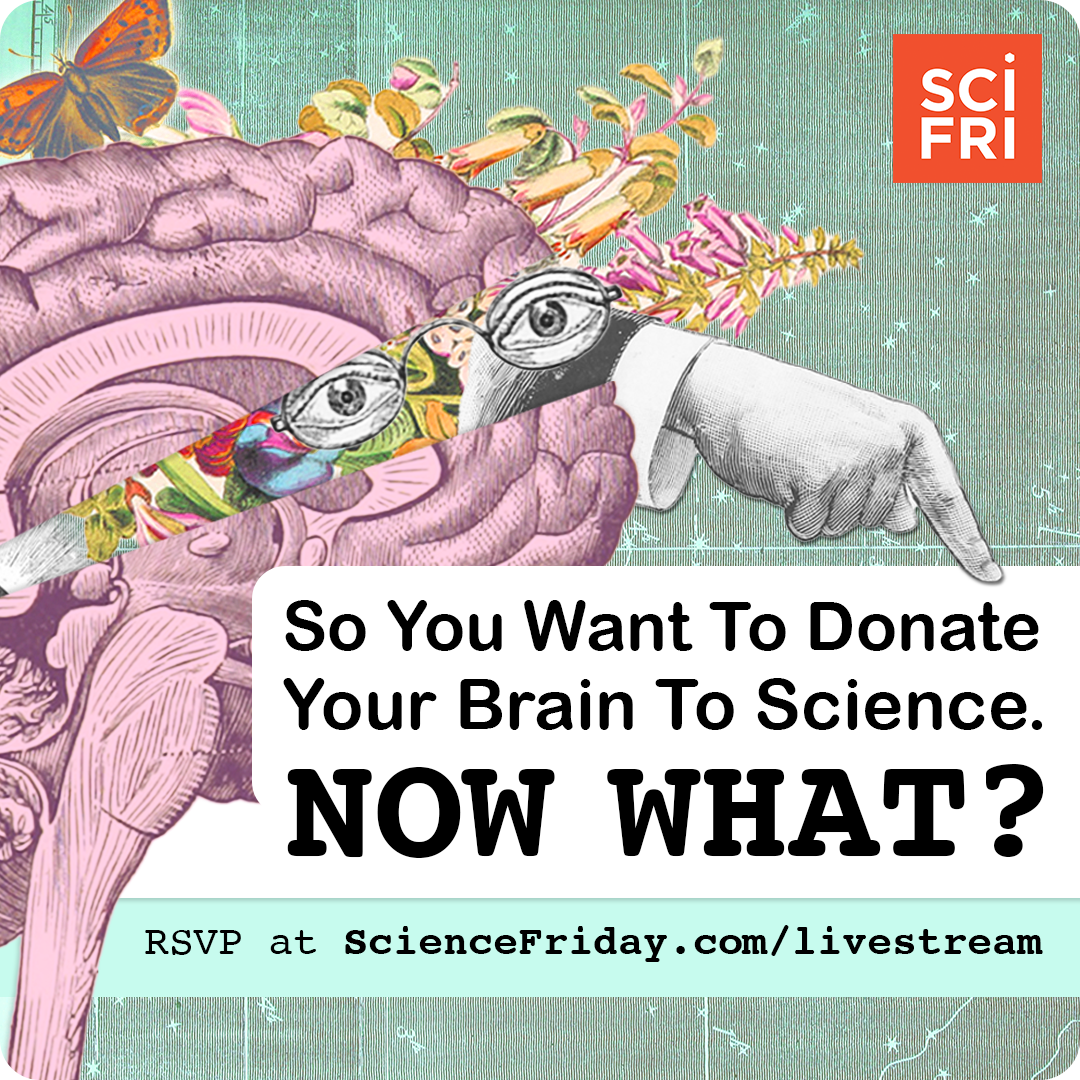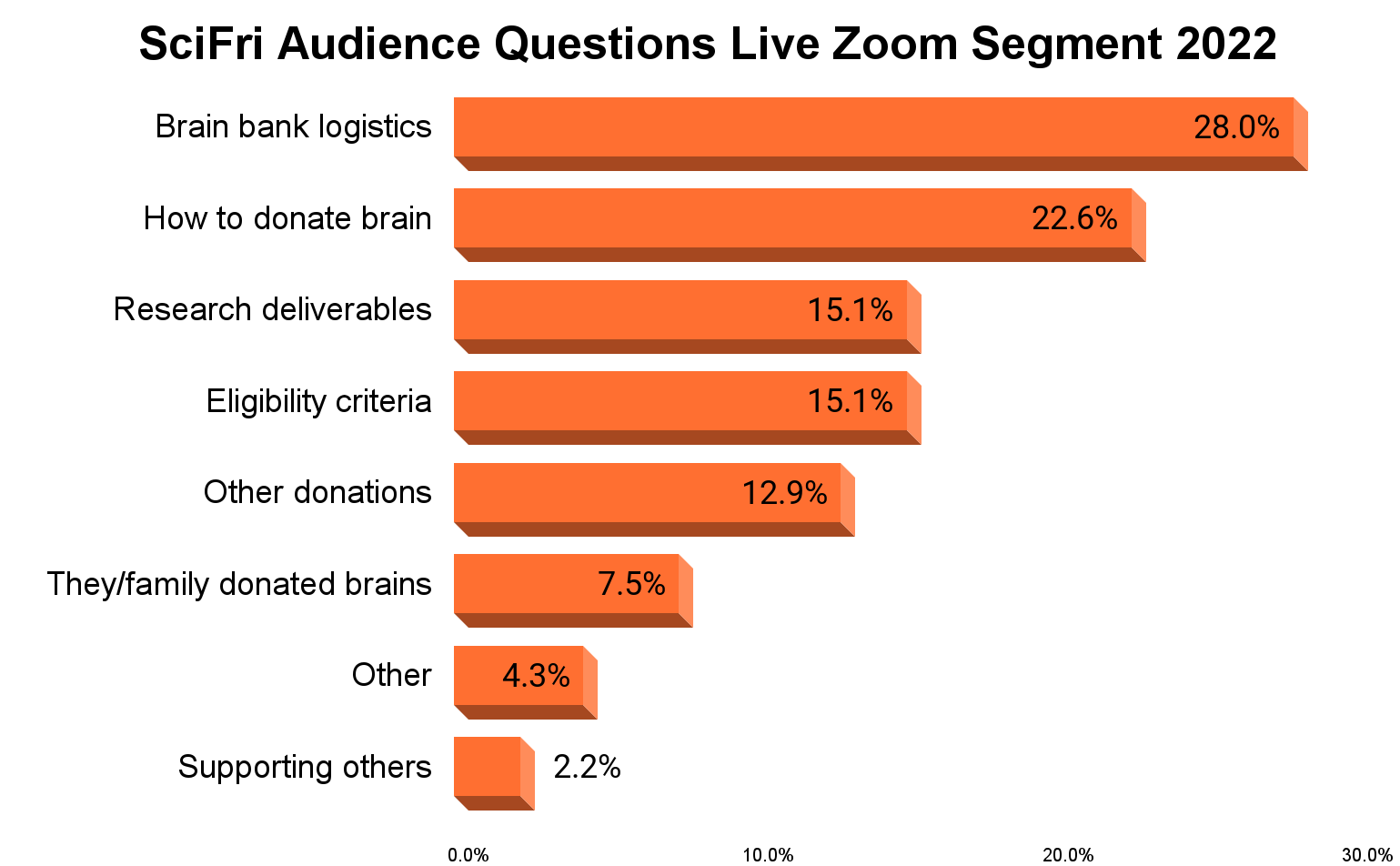Recruiting New Brain Donors For Science
A live Q&A and radio broadcast inspired over 1,000 listeners to pledge their brains to scientific research. Future brain donors share their motivations and questions about brain donation.
SciFri Findings is a series that explores new practices in journalism and science communication, and their impact on our audiences.
When Science Friday radio producer Shoshannah Bauxbaum pitched the idea of a segment about brain banking, what stood out wasn’t that brain banks are critical to understanding diseases like MS and Alzheimers. Or even that brain science is still dependent on brain tissue donation even as new imaging technologies become widely available. It was that normal brains are underrepresented in brain banks. Brain banks collect brains and other tissue samples to help researchers study conditions related to the nervous systems. They learn the most when they are able to compare and learn from different brains, including those that have and those that have not experienced disease, disorder, or trauma. However, brain donation understandably attracts those with pre-existing neurological conditions and their families, and similarly tends to attract older donors who have had time to make posthumous plans.
As our editorial team undertook production of our first ever brain banking radio story in February 2022, they sought specifically to motivate audiences to seek information about brain donation as well as to answer audience questions about the deeply personal decision to donate one’s brain after death.
The brain bank story was an opportunity to make a real difference by fielding very personal and practical questions about donation, de-stigmatizing brain disorders, and possibly even increasing interest in brain donation in listeners who had never before considered it. Our goal was to convey the science and importance of brain research networks like the NIH’s NeuroBioBank in an engaging and compelling way, and to connect interested audiences to opportunities to plan for posthumous tissue donation. In order to accomplish all this, our audience needed to be a part of the conversation.

Science Friday’s mission to increase the public’s access to scientific information includes ensuring audience members have a platform to get answers to their questions. Our Events Manager, Diana Montano, saw our Zoom production format as a good fit for this effort. Mastered during the pandemic, the Zoom recording format is exactly what it sounds like: A Zoom call with host Ira Flatow and guest experts, where audiences can listen-in live and ask questions using Zoom’s Q&A and chat features. The magic of these recording sessions is that the end product sounds exactly like the pre-pandemic, live call-in version of Science Friday.
The success of our Zoom segments relies strongly on audience questions. However, discussing the fate of one’s organs is… odd, because it tickles both our morbid curiosities (How do they get it out? Where do they store it?) as well as our heart strings (How will my surviving family feel about brain donation? Will my family be given a diagnosis?). How do you extend an authentic invitation to a discussion that is odd, interesting, and a little sad? We decided to use humor.
Working with audience and editorial leads on the project, Montano designed social media cards (see Figure 1) to provoke a feeling of curiosity and whimsy when talking about the brain. The social media posts and copy on the segment page, on-air invitation, and newsletter shoutouts for the Zoom event were light and a bit silly (“Neuroscientists and zombies have one thing in common—they need more brains!”). Over 350 people registered to participate in the Zoom event, and of those 197 (54%) ultimately attended.
Brain Donation Live Zoom Event on February 4th, 2022. The event was hosted by Ira Flatow. Tish Hevel, CEO of The Brain Donor Project (top left) and Bill Scott, the Executive Director of the University of Miami Brain Endowment Bank (top right) were guests.
Attendees to Science Friday’s brain donation discussion had interests and questions that were as diverse as they were surprising. Over the course of the hour-long event, more than 90 questions were asked, and the discussion generated hundreds of comments and replies (see Figure 2 below). It was interesting to note that more than one-quarter (28%) of questions were about brain bank logistics (e.g. how brains are stored), one-fifth (22.6%) were about the pathway to donation (e.g. Is there a form for brain donation? What are the steps?), and more than one-in-ten (15.1%) were curious about research outputs (e.g. Reports to family, study outcomes).

The Zoom questions and chat reflected a profound personal connection to the topic at hand, with many participants identifying as the family member of a recently deceased brain donor or as someone living with a mental health disorder or brain injury. There was also one particularly surprising participant group: Brain bank representatives. Multiple researchers joined and participated in the chat, representing other brain banks, hoping to attract additional recruits.
Following the highly successful Zoom event, the focus shifted to editing in order to create a radio segment that would still be valuable as a broadcast conversation. For segments like these, where novel information is provided alongside an invitation to become involved, we view our media as a middle step on the pathway to individual behavior change, in this case moving audiences to consider and pre-register for posthumous tissue donation for science.
After the edited version of the Zoom conversation aired the following Friday, we saw an outpouring of gratitude and interest from our radio audience about the brain donation discussion, and by the end of the weekend, The Brain Donor Project, which typically receives 50-100 completed donor interest forms in a week, received 900+ new brain pre-registrations, a 9x increase in brain donation interest. Over the following four weeks, The Brain Donor Project pre-registered 1,368 new brains for science.
An unexpected audience need that surfaced in questions during the Zoom event was a desire to provide support to family members who are contemplating donation. The impact of the segment extended beyond individual knowledge seeking behaviors to community level knowledge sharing and support. This was a strong example of how growing Science Friday’s impact doesn’t mean doing more to recruit our target audiences–instead, our audience-led Q&A generated a more meaningful discussion and ultimately powerful segment that connected more brains to science.
Incorporating impact design early in our program planning allowed us to consider audience-centered activation in a measurable way. Humor allowed us to connect effectively with audiences with the informality appropriate for social media, and broach a sensitive topic with kindness and grace. Journalists and science communicators should consider extending genuine invitations to audiences and stakeholders who are affected, and creating space for audiences to identify information needs for themselves. If we use this as a model for story development around difficult issues, we may be able to apply similar techniques to issues like climate change or healthcare.
What might this look like? This could include creating cute stickers for Cephalopod Week live events, or sharing amazing pictures of animal butts digitally. Humor, and dialogue, can provide an open doorway for audiences to access science.
Nahima Ahmed was Science Friday’s Manager of Impact Strategy. She is a researcher who loves to cook curry, discuss identity, and helped the team understand how stories can shape audiences’ access to and interest in science.
Ariel Zych was Science Friday’s director of audience. She is a former teacher and scientist who spends her free time making food, watching arthropods, and being outside.